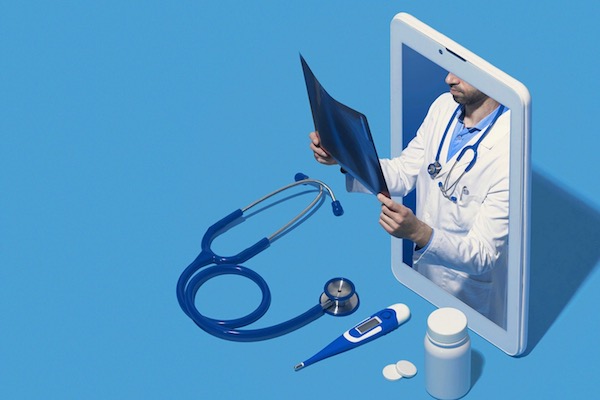Published on the 20/10/2022 | Written by Heather Wright

Project Florence to offer emerging tech for face to face interactions…
A new initiative from Sydney Local Health District’s RPA Virtual Hospital will see technologies harnessed by the virtual hospital along with new emerging technologies, rolling out for face-to-face interactions in the coming 18 months.
“Now we all have skin in the game in the decision making.”
Richard Taggart, Sydney Local Health District CIO says Project Florence is looking at how the technology RPA Virtual Hospital – or rpavirtual – has become more au fait with as well as emerging technology that is now more scalable and accessible for the health sector can be used to provide a blended, digitally enabled patient and family centred experience even when patients have a face-to-face appointment.
“So can we improve your interaction when you make an appointment booking? Can we make a more seamless check in experience? can we make it easier for you to find carparking, to find your way to the clinic or to rearrange the clinic, to ask questions before and after your visit?
“All the things many of our colleagues in retail, aviation and hospitality have perfected, or at least lead the way in, we are now applying that technology under our Florence program.”
Taggart, who was the 2021 winner of the Best in Future of Work award at last year’s IDC Future of Enterprise Awards, says the technologies will roll out ‘at scale’ across Sydney Local Health District’s health facilities over the next 12-18 months.
Speaking at IDC’s DX Summit and Future of Enterprise Awards 2022 this week, Taggart outlined the success and challenges which the virtual hospital – Australia’s first – has faced since launching in February 2020 on the same day the pandemic was declared.
The new model of care combines community care with the latest digital healthcare strategies, including use of wearables, at a quaternary (advanced level of specialised care) level.
The model was developed in recognition that it wasn’t sustainable to just keep growing physical facilities. Business plans had identified that thousands of extra beds would be required, and the services would then need to be resourced.
“We have been thinking for quite a number of years about how we can use technology to augment and enhance the existing services we provide so that we can keep people away from our hospital walls, and get them out of the hospital sooner, but also explore ways where we can provide care in a completely new paradigm that was never previously possible.”
Started as a 12-month proof of concept with an aim of seeing 2,000 patients, rpavirtual has now seen more than 70,000 patients – including handling people in the quarantine hotel program after a rapid pivot to handle the Covid changes.
“Rpavirtual rapidly expanded its models of care through Covid which was a fabulous way of testing the model,” Taggart notes.
Unlike previous telemedicine and virtual care programs, rpavirtual works in a similar way to quaternary teaching hospitals, with strong relationships with different clinical specialities and a clinical governance model to support that, along with strong relationships with university partners.
“You get the same quality and depth that you would in a quaternary physical teaching hospital, but in a virtual setting.”
Taggart’s team recently rebranded from IT services to the digital health innovation team. He says that’s in recognition of their changing role. Where previously the IT department would keep computers running in hospitals and data centres, now the team is becoming advisors and partners in developing new digitally enabled models of care and new digitally enabled patient and family experience services.
“Typically IT folk, and myself included, in previously lives would say we need to get requirements from the business before we build something or that it’s up for the business to decide and we will provide potential solutions based on what the business tell us.
“But the paradigm has shifted now.
“I think Covid has meant we now have an equal seat at the table in the way we might go about implementing a new service or modifying a service. In fact, quite often some of these digitally enabled models of care have come about from the IT people previously that we’ve now rebranded as digital to actually influencing those outcomes.”
For some on both the IT and clinical side, that’s been ‘confronting’, he admits, requiring strong collaboration to create new innovative models.
“That’s not to say we weren’t working closely together. But now we all have skin in the game in the decision making.”
Human factors have also provided some learnings along the way, Taggart says – including the issue of digital equity.
Sydney Local Health District includes some of Australia’s wealthiest, along with some of the most disadvantaged, leading to challenges such as ensuring those living in large apartment blocks and social housing can get access to videoconferencing in privacy, or whether they have a smart phone that can be paired with a wearable.
“And the biggest challenge of all is the more we digitise some of these workflows and the faster we have gone through the pandemic and beyond, the more we’ve siloed some of the experience for our clinicians,” he says.
Clinicians are working in Zoom or other videoconferencing platforms, electronic medical records, emails and other systems, with wearables added on top, creating a large integration architecture.
“The more that you integrate, the more you add to it, the slower and less agile the platform can become. That has caused us some challenges but also opportunities from the technology point of view.”
Despite the challenges, Taggart says School of Health Economics initial reports show there have been early wins, and patient surveys show patients are embracing the new model, saying the care they’ve received is as good or better than face to face care and that they enjoyed using the technology and felt the model was suitable for them.



























